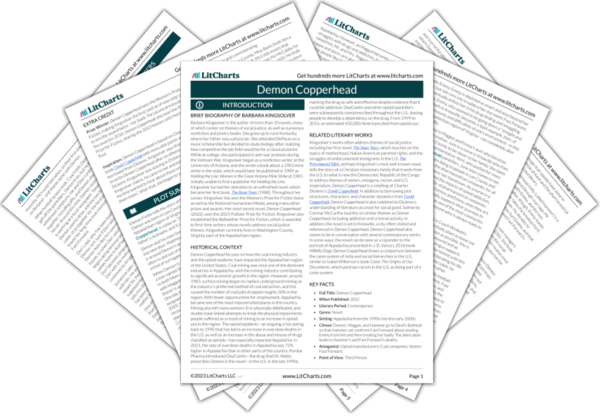Welcome to the LitCharts study guide on Barbara Kingsolver's Demon Copperhead. Created by the original team behind SparkNotes, LitCharts are the world's best literature guides.
Demon Copperhead: Introduction
Demon Copperhead: Plot Summary
Demon Copperhead: Detailed Summary & Analysis
Demon Copperhead: Themes
Demon Copperhead: Quotes
Demon Copperhead: Characters
Demon Copperhead: Symbols
Demon Copperhead: Theme Wheel
Brief Biography of Barbara Kingsolver

Historical Context of Demon Copperhead
Other Books Related to Demon Copperhead
- Full Title: Demon Copperhead
- When Published: 2022
- Literary Period: Contemporary
- Genre: Novel
- Setting: Appalachia from the 1990s into the early 2000s
- Climax: Demon, Maggot, and Hammer go to Devil’s Bathtub so that Hammer can confront Fast Forward about stealing Emmy from him and then treating her badly. The altercation leads to Hammer’s and Fast Forward’s deaths.
- Antagonist: Opioid manufacturers; Coal companies; Stoner; Fast Forward
- Point of View: Third Person
Extra Credit for Demon Copperhead
Prize Winner. Demon Copperhead won the Women’s Prize for Fiction, making Kingsolver the first (and as of now only) person to win the award twice—her book The Lacuna previously won the award in 2010. Demon Copperhead also won the Pulitzer Prize for Fiction, sharing the 2023 honors with Hernan Diaz’s Trust.
Inspiration. Demon Copperhead is based on Charles Dickens’s book David Copperfield with many plot points and characters borrowed from Dickens. Kingsolver says that she was inspired to write Demon Copperhead after an ethereal visit from Charles Dickens; Kingsolver was staying in Dickens’s home when, Kingsolver claims, he came to her and told her, “Look, nobody in my time wanted to hear about these orphans either, and I made them listen.” After that, she began to write Demon Copperhead.







